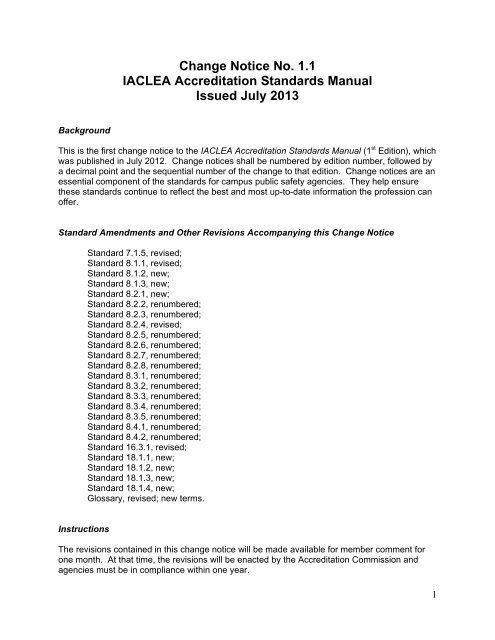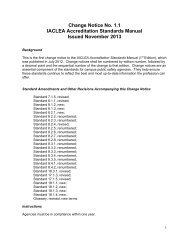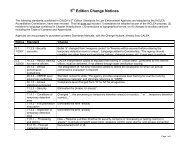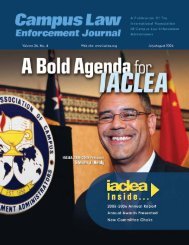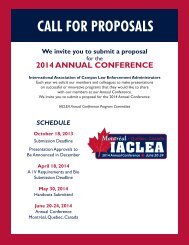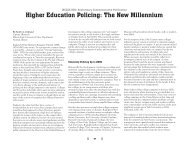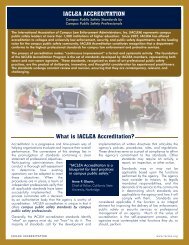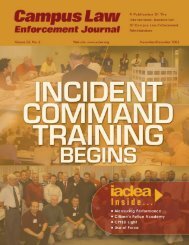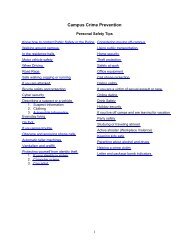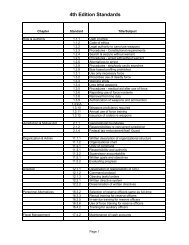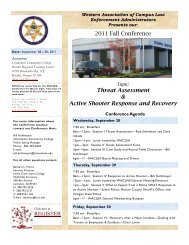Change Notice No. 1.1 IACLEA Accreditation Standards Manual ...
Change Notice No. 1.1 IACLEA Accreditation Standards Manual ...
Change Notice No. 1.1 IACLEA Accreditation Standards Manual ...
Create successful ePaper yourself
Turn your PDF publications into a flip-book with our unique Google optimized e-Paper software.
<strong>Change</strong> <strong><strong>No</strong>tice</strong> <strong>No</strong>. <strong>1.1</strong><strong>IACLEA</strong> <strong>Accreditation</strong> <strong>Standards</strong> <strong>Manual</strong>Issued July 2013BackgroundThis is the first change notice to the <strong>IACLEA</strong> <strong>Accreditation</strong> <strong>Standards</strong> <strong>Manual</strong> (1 st Edition), whichwas published in July 2012. <strong>Change</strong> notices shall be numbered by edition number, followed bya decimal point and the sequential number of the change to that edition. <strong>Change</strong> notices are anessential component of the standards for campus public safety agencies. They help ensurethese standards continue to reflect the best and most up-to-date information the profession canoffer.Standard Amendments and Other Revisions Accompanying this <strong>Change</strong> <strong><strong>No</strong>tice</strong>Standard 7.1.5, revised;Standard 8.<strong>1.1</strong>, revised;Standard 8.1.2, new;Standard 8.1.3, new;Standard 8.2.1, new;Standard 8.2.2, renumbered;Standard 8.2.3, renumbered;Standard 8.2.4, revised;Standard 8.2.5, renumbered;Standard 8.2.6, renumbered;Standard 8.2.7, renumbered;Standard 8.2.8, renumbered;Standard 8.3.1, renumbered;Standard 8.3.2, renumbered;Standard 8.3.3, renumbered;Standard 8.3.4, renumbered;Standard 8.3.5, renumbered;Standard 8.4.1, renumbered;Standard 8.4.2, renumbered;Standard 16.3.1, revised;Standard 18.<strong>1.1</strong>, new;Standard 18.1.2, new;Standard 18.1.3, new;Standard 18.1.4, new;Glossary, revised; new terms.InstructionsThe revisions contained in this change notice will be made available for member comment forone month. At that time, the revisions will be enacted by the <strong>Accreditation</strong> Commission andagencies must be in compliance within one year.1
7.1.5 Reporting Use of Force IncidentsA written directive requires that a use of force report be completed whenever an employeeofficer on or off duty and acting under color of employment with the agency (other than intraining, recreation or in an authorized instance to euthanize an animal)::a. Discharges a firearm (other than in training, recreation or in an authorized instance toeuthanize an animal);b. Applies force using lethal or less-lethal weapons; orc. Applies weaponless force or engages in actions that results in injury or harm to a personat a level defined by the department.Commentary: The agency should carefully examine all incidents wherein its employees havecaused, or are alleged to have caused, death or injury to another, have accidentally orintentionally discharged a firearm, or have applied physical force harming another. Suchreporting should occur irrespective of the employee’s duty status (i.e. on- or off-duty), whileacting under color of employment with the agency. The intent of this standard is to ensure thateach event is properly documented whenever an employee is involved in an incident of thistype. If physically able, the employee involved should be required to verbally report his/herinvolvement within a specified time period. The verbal report should be committed to writing assoon as practicable thereafter. Written procedures should state by whom, when, and how thereport will be submitted. The report may be a separate document or be incorporated into themain agency incident report.2
8 – Detainee Processing and Transportation8.1 DetentionProcessing8.<strong>1.1</strong> Designated Area for Detainee ProcessingThe agency has a written directive requiring that thedetainee processing, testing and temporarydetention of detainees occurs in designated room(s) within the facility.Commentary: Those agencies with custodial arrest authority may need to temporarily hold adetainee while certain processes are completed. Processes may include photographing, fingerprinting,charge processing, or awaiting transfer to another holding facility. Processing shouldoccur within a separate and distinctly defined area within the facility and with heightenedawareness of the officer safety risks associated with detainee processing. If the agency’sfacility cannot facilitate the safe processing of detainees, the agency should pursue anarrangement to use another agency’s processing facility.8.1.2 Procedures – Detainee ProcessingThe agency has a written directive that defines procedures for the following:a. Documenting the date, time and reason for detainees processed in and out of the facility;b. When and where individuals may be restrained by securing them to fixed objects andidentification of those fixed objects designed for such use;c. Supervision of and responsibility for testing, processing, and searching individuals withinthe facility.Commentary: Individuals should be restrained only to fixed objects that have been specificallyidentified for that purpose.8.1.3 Security Concerns – Detainee ProcessingThe agency has a written directive that addresses the security concerns in processing areas, toinclude:a. Provisions to secure weapons prior to entering processing areas;b. Duress alarms;c. Escape prevention;Commentary: The control of firearms and other weapons must be of primary concern whendealing with prisoners.8.2 Detention8.2.1 Designated Area for Temporary DetentionThe agency has a written directive requiring that temporary detention of detainees occurs indesignated room(s) within the facility.Commentary: <strong>No</strong>ne3
8.12.2 Training for Operation of Detention AreaThe agency has a written directive requiring personnel to receive training on the operation of thedetention area, to include fire suppression and equipment provided for use by the agency.Commentary: Types and levels of training should vary with the nature of assignments andresponsibilities. Employees who work in direct, continuing contact with detainees requirespecial training, including use of physical restraint, to ensure safety and security of staff anddetainees. Employees who do not work in direct contact with detainees should receive anorientation on the operation of the detention area and their role, if any. Fire suppression mayinclude smoke and fire detectors, fire extinguishers, fire hoses and air packs.8.12.3 Procedures – Temporary DetentionThe agency has a written directive that defines procedures for the following:a. Documenting the date, time and reason for detainees processed in and out of the facility;b. Providing food and water to detainees, including documentation of any meals provided;c. The maximum length of time an individual may be detained in temporary custody beforewritten justification of extended detention is required;d. The separation of males, females and juveniles while in the facility or processing area;e. When and where individuals may be restrained by securing them to fixed objects andidentification of those fixed objects designed for such use;f. Securing and monitoring individuals in locked spaces who are unattended, if allowed;andg. Supervision of and responsibility for testing, processing, searching and detainingindividuals within the facility.Commentary: Documentation of temporary custody as well as the separation of males andfemales is necessary to maintain compliance and reduce inappropriate behavior. Individualsshould be restrained only to fixed objects that have been specifically identified for that purpose.8.12.4 Security Concerns – Temporary DetentionThe agency has a written directive that addresses the security concerns in temporary detentionand processing areas, to include:a. Provisions to secure firearms prior to entering temporary detention and processingareas;b. Duress alarms;c. Escape prevention;d. Authorized access to detainee and area, if any;e. Face-to-face visual observation of unattended detainees at least every thirty minutes;and,f. If utilized, electronic surveillance devices to monitor detainees between the face-to-faceobservations.Commentary: The control of firearms and other weapons must be of primary concern whendealing with prisoners. Authorized access and duress alarms assist with preventing escapes.Visual observation helps assure the safety of the detainee.8.12.5 Conditions of Temporary Detention AreaThe agency’s temporary detention area includes access to water and restrooms.4
Commentary: <strong>No</strong>ne. (COMPLIANCE MAY BE OBSERVED)8.12.6 Fire Prevention/EvacuationThere is a plan for fire prevention, evacuation and suppression in temporary detention areas.Commentary: The plan should be in accordance with the prevailing fire code and may be part ofa larger facility plan.8.12.7 Inspection of Temporary Detention AreaA written directive describes the frequency of and procedures for inspecting temporary detentionareas.Commentary: <strong>No</strong>ne.8.12.8 Review of Temporary Detention Directives (time sensitive) (E)A written directive requires a biennial review of policies and procedures for temporary detentionareas.Commentary: <strong>No</strong>ne.8.23 Detainee Transportation8.23.1 Search of DetaineeThe agency has a written directive prescribing the security and control of detainees including,but not limited to:a. Requiring a search of all detainees prior to their being transported;b. Requiring an examination of the transport vehicle at the beginning of each shift and priorto and after transporting detainees;c. Seating arrangements in vehicles without safety barriers; andd. Restraints authorized and methods used during detainee transports.Commentary: The transporting officer is responsible for conducting a thorough search of theprisoner and all possessions of the prisoner before placing the person in the officer’s vehicle.An additional search of the prisoner should always be conducted whenever the person isreturned to the custody of the transporting officer. The officer should never assume that theprisoner has not had an opportunity to obtain a weapon or an implement of escape. At thebeginning of each shift, any vehicle used for prisoner transportation should be thoroughlysearched for contraband, weapons, or implements for escape. This should also be done beforeand after each prisoner transport. In the event the detainee must be transported in a vehiclewithout a safety barrier, the officer(s) should ensure they are able to observe the prisoner.Detainees should be restrained to ensure the safety of the transporting officer and the generalpublic and to provide for the security of the detainee in transport until arrival at the destination.5
8.23.2 Officer’s Actions at DestinationThe agency has a written directive that defines procedures for officers transporting detainees tofacilities to include:a. Safety and security of firearms;b. Removing restraining devices;c. Transmittal of documentation confirming transfer and receipt of detainee;d. Advising receiving personnel of any potential medical or security concerns for or hazardsposed by the detainee; ande. <strong>No</strong>tifying the recipient facility when the detainee is considered an unusual security risk.Commentary: Upon arrival at the transport, certain actions are necessary and important forpublic safety, officer safety, and the safety and security of the prisoner. The listed proceduresare the responsibility of the law enforcement agency and the completion of them is arequirement of the transporting officer(s).8.23.3 Transporting Sick, Injured or Physically Disabled Detainees (E)The agency has a written directive prescribing procedures for:a. Transporting sick, injured, or physically disabled detainees; andb. Security and control of detainees transported to medical care facilities or hospitals.Commentary: Because special needs will arise with certain individuals, special attention will beattracted when transporting them in public. Special attention should be given to ensure thesafety and security of both the officer and the prisoner without giving the appearance that theagency is being overbearing or inconsiderate of the prisoner. When necessary, specialtransport vehicles should be used. If the detainee is admitted to a medical facility, securityarrangements should be made with this facility that will not interfere with the treatment of theprisoner but will also minimize the escape risk. It is advised that agencies make prior contactwith hospitals and develop a procedure to be followed before the need arises.8.23.4 Driver Safety Barrier (E)Vehicles used regularly for transporting detainees have a safety barrier separating the detaineefrom the driver.Commentary: The safety barrier prevents the detainee from having access to the driver'scompartment of the vehicle. Communications between the front and rear compartments shouldnot be impaired to the point that precludes conversation. Installation of such a barrier should bedone in a manner that promotes the safety of occupants in the front and rear compartments. Itis recommended that agencies designate at least one vehicle be equipped with a barriersuitable for transporting detainees. (COMPLIANCE MAY BE OBSERVED)8.23.5 Rear Compartment ModificationsThe compartments of vehicles used for transporting detainees must be modified to minimize thepotential of the detainee exiting the vehicle without the officer’s assistance.Commentary: Modifications may consist of modular prisoner compartments, removal of interiordoor and window handles, and remote locking/unlocking. (COMPLIANCE MAY BEOBSERVED)6
8.34 Juveniles8.34.1 Procedures – Juvenile DetaineesThe agency has a written directive regarding the arrest, detention and transportation ofjuveniles, which includes:a. The rights of arrested juveniles;b. The searching of juveniles;c. The methods of transporting juveniles to detention facilities;d. The use of restraints and monitoring of the juvenile detainee;e. Approved methods and locations of detention; andf. <strong>No</strong>tifying parents or guardians of juveniles who have been taken into custody.Commentary: The intent of this standard is to guide agency personnel when arresting, detainingand transporting juveniles. These standards should complement rather than usurp any statutoryrequirements.8.34.2 Custodial Interrogation of JuvenilesThe agency has a written directive governing procedures for the custodial interview of juveniles,to include provisions for:a. Conferring with the parents or guardians;b. Explaining agency and juvenile justice system procedures to juveniles beinginterrogated; andc. Limiting the duration of the interrogation and the number of officers involved in theinterrogation.Commentary: Proof of compliance can be shown through statutes.7
16.3 Annual Campus Security Report16.3.1 Agency’s Role in Annual Campus Security and Fire Safety Reports (time sensitive)A written directive defines the role of the agency in the preparation of:a. The institution's Annual Campus Security Report; andb. The institution’s Annual Fire Safety Report. The annual campus security report andannual fire safety report are reviewed and updated annually as either one cohesivedocument or two separate documents as per the requirements of federal law (and anyother state, county, provincial, or locally required law or regulation).Commentary: The Jeanne Clery Disclosure of Campus Security Policy and Campus CrimeStatistics Act (Clery Act), codified as 20 USC 1092 (f) as part of the Higher Education Act of1965, is a federal law that requires colleges and universities to disclose both timely specificinformation and annual summary information about campus crimes and security policies. Allpublic and private institutions of postsecondary education participating in federal student aidprograms are subject to the Clery Act. The 2008 Revision of the HEOA included changes inthe testing of emergency response/evacuation procedures, fire safety, missing persons andprogram participation agreement policies within the annual campus security report. For themost current information, consult the Department of Education's Campus Security website atwww.ed.gov/admins/lead/safety/campus.html.The annual campus security report and annual fire safety report must be reviewed andupdated annually as either one cohesive document or two separate documents as per therequirements of federal law (and any other state, county, provincial, or locally required law orregulation).Congress has charged the Department of Education (DOE) with the administration of therequirements of the Clery Act, and as such the DOE is the authority having jurisdiction overcompliance with the act. Compliance with the standards contained in this chapter as theypertain to the Clery Act is in no way intended by <strong>IACLEA</strong> for agencies to conclude compliancewith federal law.8
18 – Title IXIntroductionTitle IX of the Education Amendments of 1972 (Title IX), 20 U.S.C. §§ 1681 et seq., and itsimplementing regulations, 34 C.F.R. Part 106, prohibit discrimination on the basis of sex ineducation programs or activities operated by recipients of Federal financial assistance. The lawwas originally associated with gender equity in college sports programs, causing colleges anduniversities to ensure that men and women had equal opportunities for participation. However,sexual harassment of students, which includes acts of sexual violence, is a form of sexdiscrimination prohibited by Title IX. Sexual violence is a form of sexual harassment prohibitedby Title IX. As used in this chapter, “Title IX” refers to all forms of sexual harassment and sexualviolence.Title IX compliance is clearly an institutional responsibility. However, several areas of the lawhave clear implications for the institution’s police or security unit. The standards in this chapterrepresent the minimal requirements for agencies in contributing to the institution’s overall TitleIX responsibilities. It is strongly recommended that agency CEO’s work collaboratively with theinstitution’s Title IX coordinator so that the agency’s efforts are fully integrated with overarchinginstitutional policies.18.<strong>1.1</strong> Title IX ReportingA written directive describes the agency’s procedures for responding to and reporting sexualharassment complaints.Commentary: Agency personnel may be designated as Responsible Employees, i.e. “Title IXreporters” by the institution. If so, a directive should describe steps to be taken by firstresponders and supervisory personnel when responding to an incident involving a possible TitleIX violation. Important to note is that a person’s conduct may constitute unlawful sexualharassment under Title IX even if there is no evidence of a criminal violation. It is thereforeimportant that agency personnel do not dismiss or overlook behavior that violates Title IX byconcluding that a criminal offense did not occur. Even if a criminal violation has not occurred,the institution still has a duty under Title IX to resolve complaints promptly and equitably, even ifthe complainant does not request such resolution. The directive should emphasize the agency’srole as a Title IX reporter to the institution’s Title IX coordinator and should likewise ensure thatreports of sexual harassment are properly conveyed through appropriate institutional channels.The institution’s Title IX policies and procedures may be used to satisfy all or part of thisstandard.18.1.2 Title IX TrainingTitle IX training is conducted with all agency personnel biennially, as well as with newly hiredpersonnel. Training should consist of the following:a. How to identify sexual harassmentb. The institution’s Title IX reporting and grievance proceduresc. Any other procedures used by the institution to investigate reports of sexual violence.Commentary: <strong>No</strong>ne.9
18.1.3 Title IX InvestigationsA written directive addresses situations in which a Title IX investigation and a criminalinvestigation occur concurrently, to include:a. A requirement that the Title IX investigation not be delayed pending the outcome of acriminal investigation, except for the collection of evidence.b. A requirement that the Title IX coordinator have access to agency investigation notesand findings as necessary for the Title IX investigation, as long as it does notcompromise the criminal investigation.Commentary: Title IX requires institutions to investigate reports of sexual harassment andsexual assault in a timely manner. As required by Title IX, the Title IX investigation will often beconducted concurrently with the criminal investigation. Collaboration with the institution’s Title IXcoordinator is critical. Discussions and the implementation of an MOU with local police andprosecutors is highly recommended so that those agencies understand the implications of TitleIX on the agency’s investigative and disciplinary procedures.18.1.4 Investigator TrainingIf agency personnel are responsible for investigating Title IX complaints, they receive training inconducting a civil rights investigation of sexual violence complaints, to include:a. Applicable confidentiality requirements;a. How to investigate non-stranger sexual assault; andb. The use of “preponderance of the evidence” as the evidentiary standard.Commentary: <strong>No</strong>ne10
GlossaryDETAINEE PROCESSINGThe performance of a series of actions to confirm and/or record the identity of a detainee,undertaken as a single, continuously monitored activity.SEXUAL HARASSMENTSexual harassment is unwelcome conduct of a sexual nature. It includes unwelcome sexualadvances, requests for sexual favors, and other verbal, nonverbal, or physical conduct of asexual nature.SEXUAL VIOLENCESexual violence refers to physical sexual acts perpetrated against a person’s will or where aperson is incapable of giving consent due to the victim’s use of drugs or alcohol. An individualalso may be unable to give consent due to an intellectual or other disability. A number ofdifferent acts fall into the category of sexual violence, including rape, sexual assault, sexualbattery, and sexual coercion. All such acts of sexual violence are forms of sexual harassmentcovered under Title IX.TEMPORARY DETENTIONThe unattended confinement of a detainee in the agency’s facility, for any period of time.11


